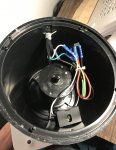gar
Senior Member
- Location
- Ann Arbor, Michigan
- Occupation
- EE
210304-1547 EST
You need to study DC and AC motor theory to understand various aspects of what you are trying to do.
A motor being brushless does not mean a whole lot. You need to know much more about the details of the motor.
These days when the words "brushless motor" are used it usually really means the motor is an AC synchronous motor ( meaning a motor with a permanent magnet rotor, and stator coils to make possible a rotating magnetic field ) with an appropriate DC to AC controller. And the DC input usually comes from an AC source.
A usual AC synchronous or induction motor is usually made without any brushes. So it is brushless, but it is not usually referred to as a brushless motor.
An AC synchronous motor always runs at synchronous speed. At 60 Hz this is 3600, 1800, 1200, and etc. speeds. Break sync ( overload the motor ) and you loose any usefulness. AC voltage control will do nothing to speed.
How an AC induction motor works ( characteristic curves ) is very dependent on rotor resistance. That is the resistance of the shorting coils wound on the rotor. With a high resistance rotor you can get a wide speed range by stator voltage adjustment, but speed regulation with load change is very poor. If high rotor resistance is produced in the rotor itself, then there is a major temperature rise problem. Thus, motors operated in this mode usually have brushes, low resistance rotor coils, and external load resistance, or some way to recover the large power output of the rotor at low speed. Some rather large motors are built this way to obtain speed control.
An AC induction motor wound with a fix low resistance rotor can not have much speed control from voltage control at a constant frequency. You have to change its frequency to change its speed.
Shaded pole motors are are only made in low power units, and if wound with a moderately high resistance rotor are capable of variable voltage speed control, but as I said above won't have good speed regulation with variable mechanical load.
A good DC permanent magnet motor will have an approximately constant torque continuous rating (may require an external fan for cooling at low speeds). Relatively good speed regulation without feedback from zero to full torque load, and for a short time can tolerate like maybe a 10 x torque overload.
.
You need to study DC and AC motor theory to understand various aspects of what you are trying to do.
A motor being brushless does not mean a whole lot. You need to know much more about the details of the motor.
These days when the words "brushless motor" are used it usually really means the motor is an AC synchronous motor ( meaning a motor with a permanent magnet rotor, and stator coils to make possible a rotating magnetic field ) with an appropriate DC to AC controller. And the DC input usually comes from an AC source.
A usual AC synchronous or induction motor is usually made without any brushes. So it is brushless, but it is not usually referred to as a brushless motor.
An AC synchronous motor always runs at synchronous speed. At 60 Hz this is 3600, 1800, 1200, and etc. speeds. Break sync ( overload the motor ) and you loose any usefulness. AC voltage control will do nothing to speed.
How an AC induction motor works ( characteristic curves ) is very dependent on rotor resistance. That is the resistance of the shorting coils wound on the rotor. With a high resistance rotor you can get a wide speed range by stator voltage adjustment, but speed regulation with load change is very poor. If high rotor resistance is produced in the rotor itself, then there is a major temperature rise problem. Thus, motors operated in this mode usually have brushes, low resistance rotor coils, and external load resistance, or some way to recover the large power output of the rotor at low speed. Some rather large motors are built this way to obtain speed control.
An AC induction motor wound with a fix low resistance rotor can not have much speed control from voltage control at a constant frequency. You have to change its frequency to change its speed.
Shaded pole motors are are only made in low power units, and if wound with a moderately high resistance rotor are capable of variable voltage speed control, but as I said above won't have good speed regulation with variable mechanical load.
A good DC permanent magnet motor will have an approximately constant torque continuous rating (may require an external fan for cooling at low speeds). Relatively good speed regulation without feedback from zero to full torque load, and for a short time can tolerate like maybe a 10 x torque overload.
.


